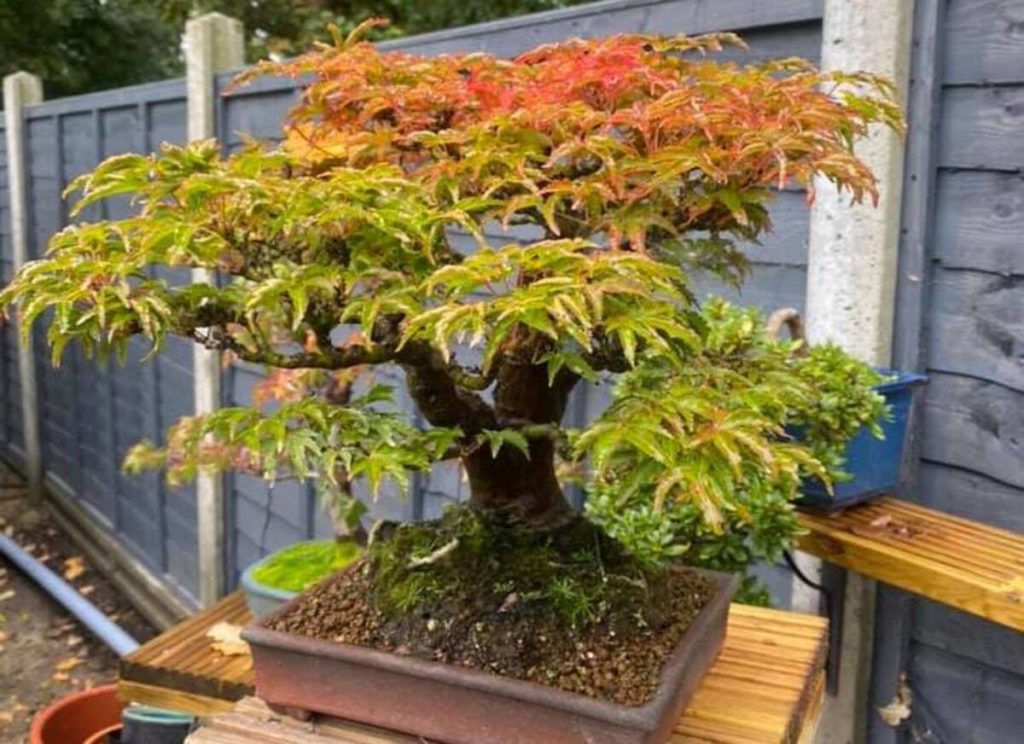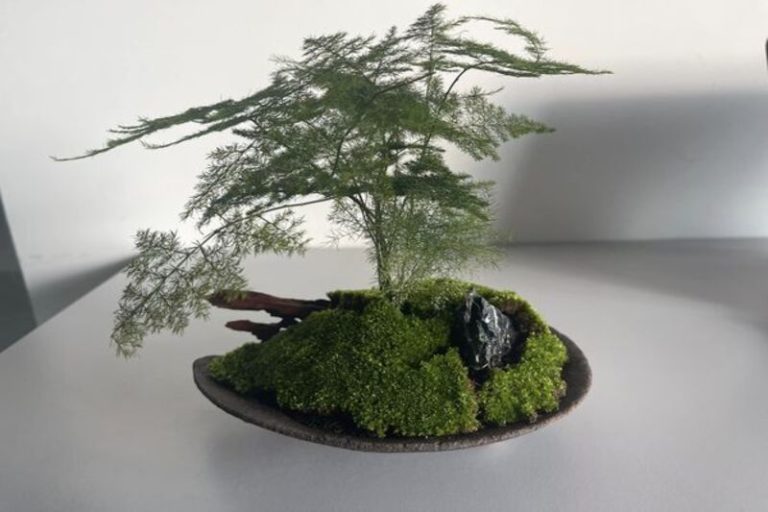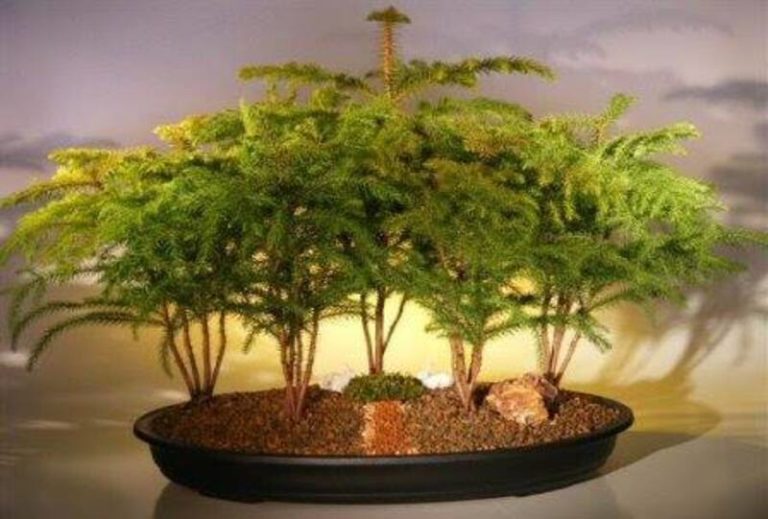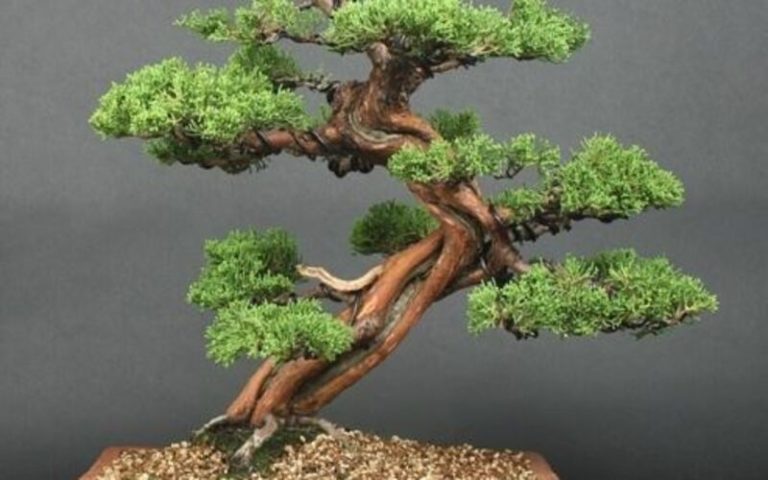Shishigashira Bonsai: A Captivating Symbol of Elegance and Grace
Bonsai is an old art form in which tiny trees are grown in pots. The Shishigashira Bonsai stands out as a unique type of bonsai. In this article will talk about Shishigashira bonsai, what makes it unique, and how to take care of it.
What is a Shishigashira Bonsai?
Shishigashira bonsai is a type of bonsai tree known for its dense, tuft-like foliage that resembles a lion’s head. It has dark green leaves that turn red in autumn. This bonsai requires well-lit conditions, moderate watering, and regular pruning to maintain its unique appearance. It is a popular choice among bonsai enthusiasts for its ornamental qualities.
History and Origins of the Shishigashira Bonsai
The Shishigashira bonsai can be tracked back to Japan, which is where bonsai as an art form started. The name “Shishigashira” means “lion’s head” in Japanese, which refers to how the bonsai’s leaves are shaped and look.
Shishigashira bonsai is considered to have initially been cultivated in Japan in the late 1800s, during the Meiji era. It is a kind of Japanese maple tree (Acer palmatum), which is highly important in Japanese society because of its beauty and what it represents.
The specific origins of the Shishigashira cultivar are not entirely clear, but it is thought to have been discovered as a naturally occurring mutation or selected from seedlings with desirable characteristics. Over time, skilled bonsai enthusiasts and growers refined the cultivation techniques to enhance its unique foliage and overall appearance.
The Shishigashira bonsai’s foliage, with its characteristic lion’s head shape and densely packed and compact leaves, drew the attention of bonsai aficionados. Its remarkable beauty and engaging presence made it a popular option among bonsai enthusiasts aiming to build aesthetically impressive bonsai displays.
Today, Shishigashira bonsai continues to be appreciated and cultivated by bonsai enthusiasts around the world. It represents the rich history and artistry of bonsai, showcasing the skill and dedication required to shape and nurture these miniature masterpieces.
Shishigashira Bonsai and Their Symbolism
Shishigashira bonsai holds symbolism and meaning that adds depth to its aesthetic appeal. Here are some interpretations associated with Shishigashira bonsai:
- Strength and Courage: The lion-like appearance of the foliage is often associated with attributes like strength, courage, and resilience. The compact and densely packed leaves resemble a lion’s mane, symbolizing power and bravery.
- Majesty and Nobility: Lions have long been associated with majesty and nobility. The lion’s head shape of the Shishigashira bonsai foliage evokes a sense of regality and grandeur, representing elegance and prestige.
- Protection and Guardianship: In some cultures, lions are seen as protective guardians. The lion-like foliage of the Shishigashira bonsai can symbolize protection, guarding against negative energies or influences and bringing a sense of security and harmony.
- Leadership and Authority: Lions are often associated with leadership and authority. The distinctive appearance of the Shishigashira bonsai can reflect qualities of leadership, asserting a strong and commanding presence.
- Transition and Change: The shifting hues of Shishigashira bonsai leaves in fall represent nature’s cycles and the beauty of transitions. It symbolizes the transitory aspect of life, reminding us of things’ impermanence and the necessity to embrace change.
It’s important to note that symbolism can vary across cultures and personal interpretations. The symbolism associated with Shishigashira bonsai can be subjective and open to individual perception. Ultimately, the symbolic meaning one attributes to this bonsai variety can be a personal reflection of their own values, beliefs, and cultural background.

Characteristics of the Shishigashira Bonsai
The Shishigashira bonsai possesses several unique characteristics that distinguish it from other bonsai varieties. Here are some notable features of the Shishigashira bonsai:
Foliage: The foliage of the Shishigashira bonsai is its most distinguishing characteristic. The leaves are densely packed and form a tuft-like or “lion’s head” shape, hence the name. The foliage is typically dark green and has a glossy appearance. During the autumn season, the leaves turn vibrant shades of red, creating a stunning display of colors.
Compact Growth Habit: Shishigashira bonsai has a naturally compact growth habit, making it an ideal choice for small-sized bonsai arrangements. The branches tend to grow in a layered fashion, giving the bonsai a well-defined and intricate structure.
Slow Growth: The Shishigashira bonsai develops at a slower rate than some other bonsai kinds. With frequent pruning and training procedures, bonsai aficionados can shape and keep its compact form because to its sluggish growth rate.
Deciduous Nature: Shishigashira bonsai is a deciduous tree, which means it sheds its leaves during the winter months. This characteristic adds to the overall beauty and interest of the bonsai, as it goes through seasonal changes and showcases different appearances throughout the year.
Ornamental Value: The Shishigashira bonsai is highly valued for its ornamental qualities. Its unique foliage and vibrant autumn colors make it a visually striking bonsai. It is often used as a focal point in bonsai displays or as a centerpiece in garden arrangements.
Cultivar Variations: Within the Shishigashira bonsai variety, there are different cultivars available, each with slight variations in leaf shape, color, and growth habit. These cultivars provide bonsai enthusiasts with options to select the specific characteristics they prefer.
The combination of the lion’s head foliage, compact growth habit, and striking autumn colors makes the Shishigashira bonsai a captivating and sought-after choice for bonsai enthusiasts and collectors alike.
Popular Shishigashira Bonsai Varieties
While there are various cultivars of Shishigashira bonsai available, here are some popular varieties known for their distinct characteristics:
1. Acer palmatum ‘Shishigashira’: This is the most common and widely recognized variety of Shishigashira bonsai. It features dense, tuft-like foliage with a compact growth habit. The leaves are dark green during the growing season and turn vibrant shades of red in autumn.
2. Acer palmatum ‘Beni Shishihenge’: This cultivar is well-known for its distinctive variegated leaves. The leaves are patterned in green, crimson, and cream, making for an eye-catching show all year. ‘Beni Shishihenge’ is a lovely color combination and gives an intriguing twist to conventional Shishigashira bonsai.
3. Acer palmatum ‘Oshio Beni Shishigashira’: This variety is highly valued for its intense red autumn foliage. The leaves transition to a deep crimson color, creating a dramatic and captivating display. ‘Oshio Beni Shishigashira’ is favored for its vibrant fall colors and adds a bold statement to any bonsai collection.
4. Acer palmatum ‘Shigitatsu sawa’: This cultivar showcases unique leaf variegation with a combination of green and white patterns. The variegated foliage adds a touch of elegance and visual interest to the Shishigashira bonsai. ‘Shigitatsu sawa’ is appreciated for its distinct appearance and the play of colors on its leaves.
5. Acer palmatum ‘Shaina’: ‘Shaina’ is a dwarf variety of Japanese maple and is often used for Shishigashira bonsai. It has a compact growth habit and shorter internodes, resulting in a more refined and miniature appearance. ‘Shaina’ is suitable for creating smaller-sized Shishigashira bonsai with intricate foliage.
These are just a few of the most famous types of Shishigashira bonsai. Each cultivar has its own unique traits, like variegation, strong fall colors, or tight growth, so bonsai fans can choose the variety that best fits their tastes and desired look.
How to Grow a Shishigashira Bonsai
Growing a Shishigashira bonsai requires proper care and attention to ensure its health and aesthetic appeal. Here are some key steps to grow a Shishigashira bonsai successfully:
- Selection of Bonsai Tree: Start by obtaining a young Shishigashira bonsai tree from a reputable nursery or bonsai specialist. Look for a healthy tree with well-developed foliage and a compact growth habit.
- Container and Soil: Choose a suitable bonsai container that provides good drainage. Use a well-draining bonsai soil mix composed of a combination of organic and inorganic materials, such as akadama, pumice, and lava rock. This type of soil mixture promotes proper water drainage and aeration for the bonsai’s root system.
- Light and Temperature: Shishigashira bonsai grows well in indirect light. Place it in a spot that receives plenty of sunshine or moderate shade, especially in the morning and late afternoon. Protect the bonsai against high winds and dramatic temperature variations.
- Watering: Water the Shishigashira bonsai thoroughly whenever the top inch of soil feels slightly dry. Use a gentle watering technique to prevent soil erosion. Ensure that excess water drains out of the container to avoid waterlogged roots, which can lead to root rot. Adjust the watering frequency according to the season and environmental conditions.
- Pruning and Shaping: Regular pruning is crucial for maintaining the compact and tuft-like foliage of the Shishigashira bonsai. Prune back excessive growth, including long branches and unwanted shoots. Shape the bonsai by wiring the branches to create the desired form. Avoid heavy pruning during the growing season to prevent stress on the tree.
- Fertilization: Feed the Shishigashira bonsai with a balanced, slow-release bonsai fertilizer during the growing season. Follow the recommended dosage and frequency specified on the fertilizer package. Adjust the fertilization regimen based on the tree’s growth and overall health.
- Protection from Pests and Diseases: Inspect the bonsai regularly for pests like aphids, spider mites, and scale insects. Treat any infestations promptly using appropriate organic or chemical methods. Keep an eye out for signs of diseases such as powdery mildew or leaf spot and take appropriate measures to address them.
- Seasonal Care: Shishigashira bonsai requires special attention during winter dormancy. Protect the bonsai from freezing temperatures by providing insulation or moving it to a protected area like an unheated garage or greenhouse. Avoid watering excessively during this period.
- Continued Maintenance: Regularly monitor the health of the Shishigashira bonsai and make adjustments to its care routine as needed. Continue to prune, shape, fertilize, and water the bonsai based on its specific requirements and growth patterns.
By following these steps and providing proper care, you can cultivate a healthy and visually appealing Shishigashira bonsai that will continue to develop and thrive over time. Remember to be patient and enjoy the rewarding process of growing and nurturing your bonsai.
Benefits of the Shishigashira Bonsai
The Shishigashira bonsai offers several benefits beyond its aesthetic appeal. Here are some notable advantages of having a Shishigashira bonsai:
Therapeutic and Relaxing: Growing and caring for a bonsai, like the Shishigashira kind, may be a relaxing and soothing experience. Pruning, shaping, and viewing the growth of the bonsai can help relieve stress, enhance awareness, and create a sense of calm.
Compact Size: Shishigashira bonsai has a naturally compact growth habit, making it an excellent choice for those with limited space. Its small size allows it to be placed on tabletops, desks, or smaller outdoor areas, adding a touch of natural beauty to any setting.
Indoor and Outdoor Versatility: Shishigashira bonsai can be grown both indoors and outdoors, depending on the climate and specific care requirements. It can thrive indoors with proper lighting and care, making it suitable for individuals who live in apartments or regions with harsh outdoor conditions.
Visual Appeal: The unique foliage of the Shishigashira bonsai, resembling a lion’s head, adds a captivating and distinctive element to any space. Its dense and tuft-like leaves, coupled with the vibrant autumn colors, create a visually appealing display throughout the year.
Educational Value: Growing a Shishigashira bonsai offers an opportunity for learning and honing horticultural skills. It allows individuals to understand the principles of plant care, including watering, pruning, and fertilization. Bonsai cultivation can also deepen one’s appreciation for nature and the artistry involved in shaping and nurturing a miniature tree.
Symbolic Significance: Like other bonsai varieties, the Shishigashira bonsai holds symbolic meanings associated with its unique appearance. It can serve as a reminder of strength, resilience, and the beauty of transitions in life, adding a deeper layer of significance to its presence.
Bonsai Community and Appreciation: Engaging in bonsai, particularly Shishigashira bonsai, allows you to engage with a thriving network of bonsai aficionados. Participating in seminars, shows, or online forums may give a venue for exchanging experiences, information, and a mutual appreciation for the creative form.
The Shishigashira bonsai encompasses both aesthetic and therapeutic benefits, making it a rewarding and enriching addition to any living space or garden. Its unique characteristics and symbolism contribute to a sense of tranquility, beauty, and connection to nature.
Displaying Shishigashira Bonsai:
When it comes to presenting your Shishigashira bonsai, you have a few alternatives. Make sure it gets enough light, whether you put it indoors or outside. You may also add appropriate decorations to the display, such as accent plants, pebbles, or tiny figurines. Adding an aesthetically stunning exhibit to your Shishigashira bonsai will enhance its beauty.
Styling and Design of a Shishigashira Bonsai
The styling and design of a Shishigashira bonsai involve shaping and training the tree to accentuate its unique characteristics. Here are some considerations and techniques for styling and designing a Shishigashira bonsai:
1. Compact Form: The Shishigashira bonsai is known for its naturally compact growth habit. Emphasize this characteristic by maintaining a dense and tuft-like foliage structure. Regular pruning is essential to keep the branches and foliage in proportion and to create a balanced overall shape.
2. Lion’s Head Shape: The goal is to create a bonsai that resembles a lion’s head with its foliage. Encourage the development of a rounded canopy by allowing the branches to grow outward and slightly upward. Regular trimming and pinching of the new growth will help maintain the lion’s head appearance.
3. Branch Structure: Aim for a well-structured branch system that complements the overall design. Encourage the growth of secondary and tertiary branches to add depth and dimension to the bonsai. Remove any crossing or competing branches that disrupt the overall flow and balance.
4. Wiring: Wiring is often used to shape and position branches in the desired direction. Carefully wrap bonsai wire around branches, following their natural curvature. Be mindful not to apply excessive pressure that could damage the branches. Adjust the wiring periodically as the branches thicken and grow.
5. Pruning: Regular pruning is crucial to maintain the compact form of the Shishigashira bonsai. Remove any excess growth, especially long shoots or branches that disrupt the overall shape. Prune during the appropriate season, usually in spring or early summer, to promote healthy growth and maintain the desired design.
6. Balance and Proportion: Achieving balance and proportion is essential in bonsai design. Consider the height and width of the bonsai, ensuring that the visual weight is evenly distributed. The apex or top of the bonsai should align with the lower branches to create a harmonious composition.
7. Patience and Observation: Styling and designing a Shishigashira bonsai is an ongoing process that requires patience and observation. Regularly evaluate the tree’s growth, making adjustments as needed to maintain the desired form. Pay attention to the tree’s response to pruning and wiring, allowing it time to recover and adapt.
Remember that styling a Shishigashira bonsai is a creative endeavor, and personal preferences may influence the final design. It is essential to strike a balance between shaping the tree to highlight its natural beauty while respecting its inherent characteristics. With time, dedication, and careful craftsmanship, a stunning and unique Shishigashira bonsai can be created.
How to Care for and Maintain a Shishigashira Bonsai
Caring for and maintaining a Shishigashira bonsai involves regular attention to its specific needs. Here are some essential care tips to keep your Shishigashira bonsai healthy and thriving:
- Watering: Check the moisture level of the soil regularly and water the bonsai when the top inch of soil feels slightly dry. Use a gentle watering technique to ensure thorough saturation of the soil without causing waterlogging. Adjust the watering frequency based on the season, humidity levels, and the bonsai’s specific requirements.
- Light and Temperature: Place your Shishigashira bonsai in a location that provides bright, indirect sunlight. It thrives in partial shade as well. Avoid exposing the bonsai to extreme temperature fluctuations and strong winds, as they can stress the tree. Protect it from frost or freezing temperatures during winter dormancy.
- Fertilization: Feed your Shishigashira bonsai with a balanced bonsai fertilizer during the growing season, typically from spring to early autumn. Follow the instructions on the fertilizer package for dosage and frequency. Reduce or cease fertilization during the winter dormant period.
- Pruning and Shaping: Regular pruning is crucial for maintaining the compact form and shape of the Shishigashira bonsai. Remove any excessive growth, including long branches and unwanted shoots. Prune during the appropriate season, generally in spring or early summer. Shape the bonsai by wiring branches to achieve the desired design.
- Soil and Repotting: Shishigashira bonsai prefers well-draining soil to prevent waterlogging and promote healthy root development. Repot the bonsai every two to three years or as needed, typically during spring or early autumn. Use a bonsai soil mix that provides adequate drainage and nutrients.
- Pest and Disease Control: Regularly inspect your Shishigashira bonsai for pests like aphids, spider mites, or scale insects. Treat any infestations promptly using appropriate organic or chemical methods. Monitor the bonsai for signs of diseases such as powdery mildew or leaf spot, and take appropriate measures to address them.
- Winter Care: During winter, protect the Shishigashira bonsai from freezing temperatures. Provide insulation or move it to a sheltered location, such as an unheated garage or greenhouse. Water sparingly during winter dormancy, ensuring the soil remains slightly moist but not overly saturated.
- Observations and Adjustments: Regularly observe the health and growth of your Shishigashira bonsai. Adjust the care routine, such as watering, fertilization, and pruning, based on the bonsai’s response and specific requirements. Consider its overall well-being and make necessary adjustments to maintain its health and vitality.
Remember that caring for a Shishigashira bonsai is an ongoing process that requires patience and attention to detail. Each bonsai is unique, and its specific care needs may vary. By providing proper care, you can enjoy a beautiful and thriving Shishigashira bonsai for years to come.
Shishigashira Bonsai Care Sheet
| Aspect | Care Tips |
| Watering | Water when the top inch of soil feels slightly dry. |
| Ensure thorough watering without waterlogging the soil. | |
| Sunlight | Provide bright, indirect sunlight or partial shade. |
| Temperature | Protect from extreme temperature fluctuations and winds. |
| Humidity | Moderate humidity levels are generally suitable. |
| Fertilization | Feed with a balanced bonsai fertilizer during the growing season. |
| Follow instructions on the fertilizer package for dosage and frequency. | |
| Pruning and Trimming | Regularly prune excessive growth, maintaining the compact form. |
| Prune during the appropriate season, typically in spring or early summer. | |
| Wiring and Styling | Use wiring to shape branches, following their natural curvature. |
| Adjust wiring periodically as branches thicken and grow. | |
| Repotting | Repot every two to three years, using well-draining bonsai soil mix. |
| Repot during spring or early autumn. | |
| Pest and Disease Control | Regularly inspect for pests like aphids, spider mites, or scale insects. |
| Treat infestations promptly using appropriate methods. | |
| Winter Care | Protect from freezing temperatures with insulation or by moving indoors. |
| Water sparingly during winter dormancy. | |
| Regular Maintenance | Observe and adjust care routine based on bonsai’s response and needs. |
| Maintain overall health through regular care and attention. |
Remember that this care sheet provides general guidelines for Shishigashira Bonsai care. It’s important to also consider the specific needs of your bonsai and make adjustments accordingly. Regular observation and ongoing maintenance are key to the health and vitality of your Shishigashira Bonsai.
Shishigashira Bonsai as a Collectible and Investment:
Mature Shishigashira bonsai can be considered collectibles and even investments. Their value increases with age and rarity. If you’re passionate about bonsai, you may find joy in building a collection. When assessing the investment potential, consider factors such as the bonsai’s condition, age, and historical significance. Connecting with bonsai collectors and enthusiasts can provide valuable insights and networking opportunities.
Conclusion:
Shishigashira bonsai is a fascinating and beautiful plant that offers a unique addition to any bonsai collection. By understanding its care requirements, you can nurture and enjoy its lush foliage for years to come. Whether you’re a bonsai enthusiast or a business catering to bonsai lovers, optimizing your content for search engines can help attract more people to this captivating art form. So, let’s delve into the world of Shishigashira bonsai and appreciate the beauty it brings.
FAQ:
Q: What is a Shishigashira Bonsai?
A: Shishigashira Bonsai is a Japanese maple variety with dense, lion’s head-like foliage.
Q: How do you care for Shishigashira?
A: Provide bright, indirect sunlight; water when the top inch of soil is slightly dry; prune to maintain shape; fertilize during the growing season; protect from extreme temperatures and pests.
Q: How fast does Shishigashira grow?
A: Shishigashira Bonsai has a slow to moderate growth rate.
Q: Can Shishigashira Bonsai be grown indoors?
A: Yes, with proper light and care.
Q: When should I prune my Shishigashira Bonsai?
A: Prune during spring or early summer when it’s actively growing.
Q: Can I wire the branches of my Shishigashira Bonsai?
A: Yes, but avoid excessive pressure or damage to branches. Monitor and adjust wiring as needed.
Also Read:







